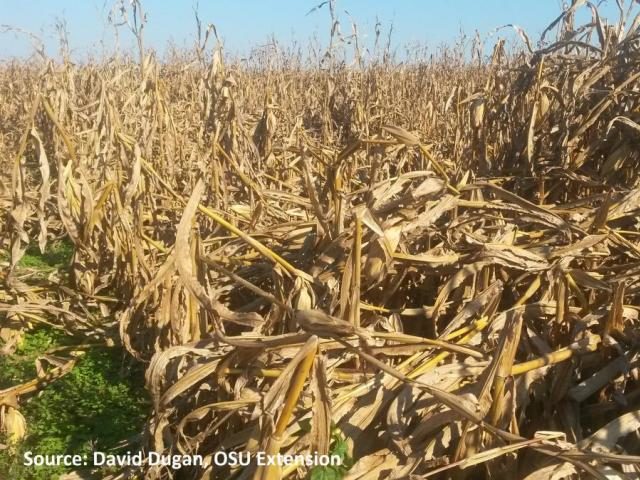By Peter Thomison, Corn Cropping Systems Extension Specialist
 While never a recommended practice, this is definitely not the year to “store” corn in the field and delay harvest. Reports of lodging and downed corn are increasing across the state. Stalk rots are largely responsible for the problem, which have been promoted by stressful production environments and susceptible hybrids.
While never a recommended practice, this is definitely not the year to “store” corn in the field and delay harvest. Reports of lodging and downed corn are increasing across the state. Stalk rots are largely responsible for the problem, which have been promoted by stressful production environments and susceptible hybrids.
Affected corn stalks are characterized by internal plant tissue that has disintegrated and often appears “hollowed out”. These symptoms are also often present in the crown of the plant. Severe lodging slows the harvest operation, causing delays that expose the crop to less favorable weather conditions, as well as wildlife damage. Another loss may occur if ear rots develop when ears on lodged plants come in contact with wet soils and surface residues.
Even certain hybrids that normally exhibit good standability and stalk quality are exhibiting significant lodging. According to some grower accounts, corn that had been standing well, collapsed in the course of a few days. In these extreme situations, growers may face major challenges harvesting lodged corn, which is nearly flat on the ground.
The following are tips from Mark Hanna, an extension agricultural engineer in agricultural and biosystems engineering at Iowa State University:
“Scout fields to determine where problem areas are and the condition of stalks and ears. Harvest the problem areas first when field conditions are better and before kernels in close proximity to the ground have an opportunity for potential further deterioration. An exception might be made to harvest an area with particularly weak stalk strength that is still standing if the odds of lodging from weather seem high.
“The only way to evaluate whether any harvesting aid or technique is helping is to measure harvest losses. Each ¾-pound ear on the ground per 436 square feet equals a loss of one bushel per acre. Detailed instructions for measuring losses are in Profitable Corn Harvesting. Take a measuring tape to the field at harvest and spend a few minutes behind the combine checking losses.
“Tips for machine operation to reduce losses:
- “Set gathering chains for more aggressive operation with points opposite each other and relatively closer together. Adjust deck plates over snapping rolls only slightly wider than cornstalks so that they hold stalks but not so narrow that stalks wedge between the plates.
- “Operate the head as low as practical without picking up rocks or significant amounts of soil.
- “Single-direction harvesting against the grain of leaning stalks may help. Evaluate losses though before spending large amounts of time dead-heading through the field.
- “Limited field measurements suggest a corn reel may or may not help limit machine losses; however, a reel likely allows greater travel speed and improves productivity. Losses may be similar comparing harvest at 1 mph without a reel and 3 mph with a reel, but harvest goes much faster. Spiral cones mounted atop row dividers or the addition of higher dividers on each end of the cornhead are other potential after-market harvest aids.
- “If harvest speeds are significantly reduced, the amount of material going through the combine is reduced. Fan speed may need to be reduced to avoid blowing kernels out of the combine. Rotor speed may need to be reduced to maintain grain quality. Check kernel losses behind the combine and grain quality to fine tune cleaning and threshing adjustments.
- “Grain platforms have been used to harvest corn in relatively severe cases. More cornstalks and material other than grain enters the combine. Expect capacity to be reduced somewhat. Concave clearance may need to be increased for increased throughput and fan speed may need to be increased to aid separation in the cleaning shoe…
“Perhaps as important as anything, get into the correct frame of mind and keep the right mental attitude. Recognize that speeds will be slower. Communicate these expectations with others. Don't allow an accident to compound harvest problems.”
Several companies sell equipment for picking up lodged corn.






